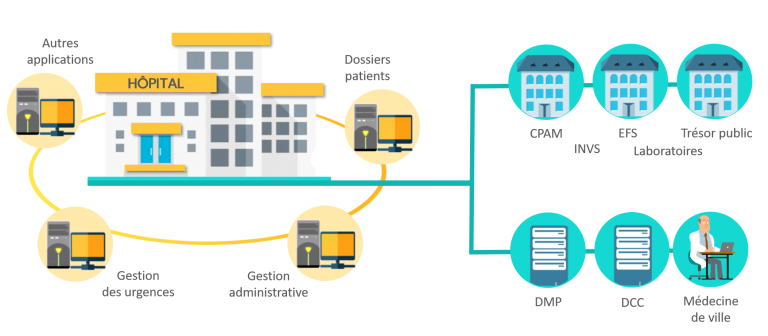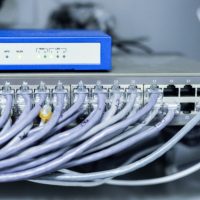1. Interop et santé
L’interopérabilité se définit comme la capacité de systèmes différents ou identiques à pouvoir communiquer facilement entre eux. Deux logiciels sont donc interopérables, dès lors qu’ils communiquent ensemble.
En santé, on distingue l’EAI (Enterprise Application Integration, en jaune) pour les flux à l’intérieur d’un établissement et l’EDI (Electronic Data Interchange, en bleu) pour les flux standardisés partants vers l’extérieur de l’établissement.

En EAI, le format le plus répandu est le HL7 (Health Level 7). Ce format est basé sur la génération de fichiers spécifiques à l’occasion d’évènements particuliers dans la vie de l’établissement. En fonction de l’évènement, la structure et le contenu du fichier s’adaptent alors pour transmettre le maximum d’informations utiles de façon organisée.
Le HL7 se décline en plusieurs versions :
- Version 2.x (1987) : fichier « plat » divisé en segments et en champs par des caractères séparateurs définis dans le fichier.
- Version 3 <=> CDA (1997) : ajout d’une syntaxe XML. Les mêmes informations se retrouvent structurées et regroupées en balises.
- Version 4 <=> FHIR (2014) : ajout d’une couche web/API pour faciliter l’intégration et l’utilisation des données.
Le HL7 permet donc de structurer l’échange de données. En complément, des organismes tels que IHE (Integrating the Healthcare Enterprise) et Interop’ Santé rédigent des recommandations pour standardiser l’interprétation de ces données, notamment avec des profils tels que IHEPAM pour la gestion des identités et des extensions pour les particularités nationales.
2. Interop et exolis
Le succès de notre solution repose sur une intégration forte aux SIH existants des établissements. Nous tâchons, dans ce sens, de respecter les standards d’interopérabilité et gérons les formats principaux :
- HL7 V2 (v2.3, v2.4, v2.5) :
- ADT : identité patient, personne de confiance, séjour, couverture sociale
- SIU : rendez-vous, ressources et statut du déroulement du rendez-vous
- MDM : transmission de documents
- ORU : transmission de documents
- MFN : gestion des référentiels
- HPRIM
- CDA
- FHIR
La réception de la majorité des informations en entrée nous permet de réagir automatiquement et ainsi éviter d’utiliser des ressources humaines :
- Envoi automatique d’un e-mail pour création de compte lorsqu’une venue est créée dans le SIH,
- Inclusion automatique dans un parcours spécifique en fonction du code d’acte, du motif de séjour, du médecin, de l’UF ou du type de compte-rendu présent dans les fichiers,
- Décalage du scénario et de la chronologie de questionnaire si l’intervention ou le rendez-vous est décalé.
Mais nous complétons notre offre par des connexions spécifiques, via web-services ou import/export de fichiers, si elles sont nécessaires. Ces connexions peuvent faire l’objet de développements complémentaires sur option. Nous pouvons donc communiquer avec toutes les solutions exploitées au sein des établissements. Nous développons, en interne, des demi-connecteurs ad hoc permettant une connexion avec tous les outils.
Nous sommes aujourd’hui interconnectés avec plus de 30 applications diverses : Dossier Patient, Gestion administrative, Agendas, Gestion Laboratoires, Logiciel imagerie, logiciel d’oncologie, mais aussi communautés d’aidants.
N’hésitez pas à nous contacter via interop@exolis.fr si vous souhaitez des précisions sur les flux existants ou échanger sur un besoin particulier.
3. Foire aux questions
Intégration au SI d’un établissement
Notre outil est complémentaire de ces logiciels car il permet l’accompagnement du patient « hors les murs ». De ce fait nous sommes interopérables avec les logiciels présents dans l’établissement ce qui nous permet de recevoir et de transmettre les informations pour faire l’interface avec les patients.
Oui, les équipes d’exolis peuvent paramétrer autant de connecteurs en entrée et en sortie que nécessaire. Il est donc possible de gérer plusieurs flux de RDV, si l’établissement possède plusieurs agendas.
Gestion des flux pour un groupement d'établissements
Dans le cadre d’un groupement, nous sommes capables de connecter notre outil aux différents logiciels locaux dans les établissements ainsi qu’au SRI, en place s’il est présent.
Dans le cadre de la pré-admission, voici un exemple de workflow possible :

Une des fonctionnalités de notre outils permet de gérer des patients et des parcours partagés entre plusieurs établissements. Cependant, chaque groupe possède ses propres particularités. Je vous invite à nous contacter à l’adresse interop@exolis.fr pour en discuter plus spécifiquement.
Connexion par exolis
Les demi-connecteurs et l’interopérabilité ne génèrent, en général, pas de frais supplémentaires sur les modules souhaités. Tout est compris dans la licence d’exploitation au début du projet.
Nous pouvons recevoir des flux standardisés sans particularités. Il est donc tout à fait possible de nous connecter directement au noyau existant via un branchement en Y dans un EAI.






